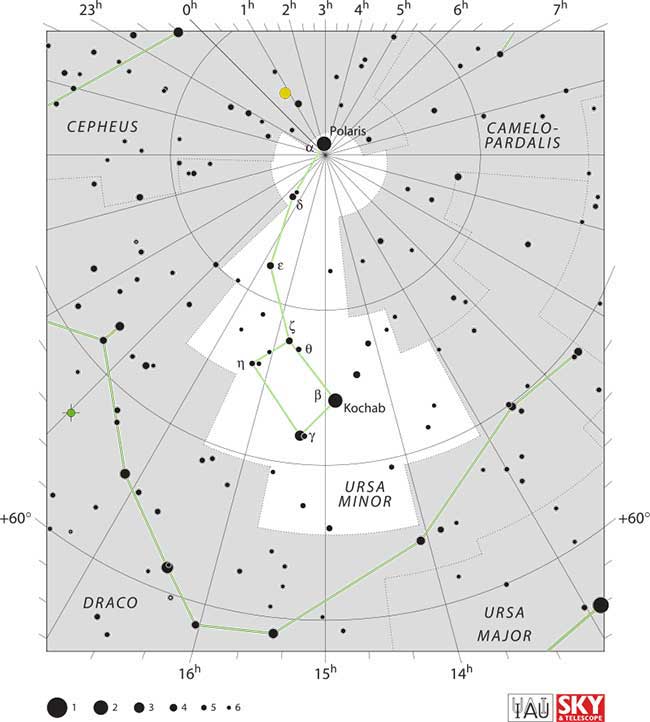The Little Dipper
The Little Dipper is a pattern of stars found in the Ursa Minor constellation (i.e. Little Bear). Similar to the Big Dipper, the handle forms the tail of the little bear, while the bowl forms the bear’s flake/hindquarters. The Little Dipper is an asterism and is not considered a formal constellation.
The Little Dipper contains Polaris (i.e. the North Star or Pole Star) which is located almost directly above the North Celestial Pole and marks the direction of due north. For this reason, Polaris is a known navigational tool.
Stars in the Little Dipper
The stars in the Little Dipper were named after a cartographer who used Greek letters alpha to label the most prominent stars in the constellation. There are seven stars that make up the Little Dipper, they include:
- Polaris
- Delta
- Epsilon
- Zeta
- Eta
- Pherkad
- Kochab
Names of the stars in Little Dipper and their approximate magnitude. John Chumack
The Handle
Alpha Ursae Minoris (Polaris)
Polaris, or Pole Star, is the end of the handle (or Bear’s tail) and is the brightest star in the Ursa Minor constellation.
It is a yellow-white supergiant with an apparent magnitude of 2.02 and a varying spectral type of F7lb/F8lb. Polaris is a triple star system that includes Polaris Aa and its dimmer counterparts, Polaris Ab and Polaris B which are approximately 434 light-years away.
Due to its close proximity to the rotational axis of Earth, the star appears motionless in the sky which makes it an important star in celestial navigation.
Delta Ursae Minoris
Delta is a white main sequence dwarf star with a visual magnitude of 4.35. It is of the spectral type A1V, is 47 times more luminous than the Sun and approximately 175 light-years from Earth.
Epsilon Ursae Minoris
Epsilon is a triple star system with an overall brightness that varies from 4.19 to 4.23 in magnitude. The system includes a yellow G-type giant, which is also an eclipsing spectroscopic binary star and is orbited by an 11th magnitude star. Epsilon is approximately 347 light-years away.
The Bowl
Zeta Ursae Minoris
Zeta is a white main-sequence star of spectral type F5V with a visual magnitude of 4.32. It is approximately 380 light-years away from Earth.
Eta Ursae Minoris
Eta is a main sequence dwarf with a visual magnitude of 4.95, making it the dimmest of the seven stars. This star is 97 light-years away from Earth.
Gamma Ursae Minoris (Pherkad)
Pherkad, forming the top end of the bowl, is a white bright giant with an apparent magnitude that varies between 3.04 and 3.09. It is also known, along with Kochab, as the ‘guardians of the pole star’.
Beta Ursae Minoris (Kochab)
Kochab forms the lower outer bowl and is an orange giant star only slightly fainter than Polaris at an apparent magnitude of 2.08. It is approximately 131 light-years from Earth and is known as the other ‘guardian of the poke star’ along with Pherkad.
How to Find the Little Dipper?
The Little Dipper is visible between latitudes 90 and -10 with the best time to observe in the month of June. However, since the stars in the Little Dipper range in brightness from second to fifth magnitude, it may be difficult to see depending on the quality of your night sky.
Polaris nearly in line with the North Celestial Pole. IAU/Sky & Telescope
Light pollution in the form of sky glow from urban city centers and surrounding suburbs affects the overall darkness of the sky. With the stars in the bowl being so dim, you will need a darker sky in order to see them. This would explain why you might not be able to locate the Little Dipper.
While you might not be able to see the Little Dipper, you can use the stars from the Big Dipper to locate Polaris. Simply locate the outer two stars in the Big Dipper bowl (Merak and Dubhe) and draw an imaginary line through both stars, extended outwards until you locate a bright star forming the end of the Little Dipper handle.
The Big and Little Dipper are arranged with their handles pointing in opposite directions, meaning one Dipper is upright while the other is upside down.
Deep-sky objects near the Little Dipper
Unlike its Big Dipper counterpart, the Little Dipper does not have many nearly deep-sky objects. A few include the Ursa Minor Dwarf (spheroidal galaxy), NGC 3172 (faint galaxy closest to the North Celestial Pole), NGC 6217 (barred spiral galaxy) and NGC 6251 (radio galaxy).
Though there is a lack of deep-sky objects nearby, the Ursids is a prominent meteor shower that occurs within the Ursa Minor constellation between December 18 and 25. Observers should plan to view from midnight to dawn for the best chance of viewing meteors.



